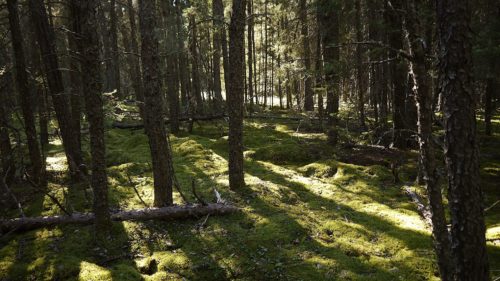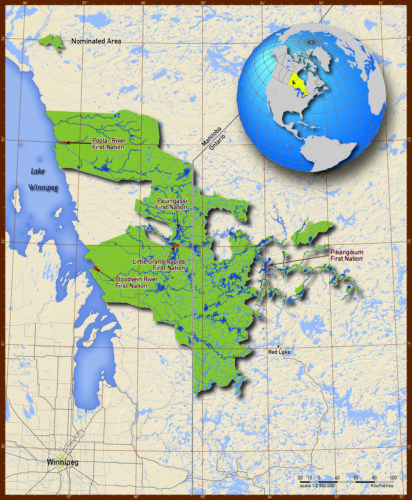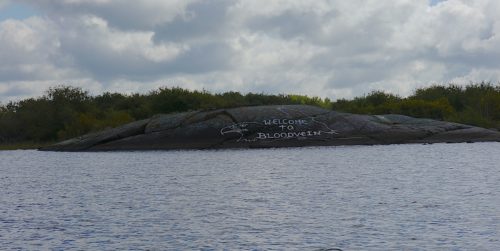MANITOBA — In 2002, the five Anishinaabe First Nations of Bloodvein River, Little Grand Rapids, Poplar River, Pikangikum and Pauingassi joined forces with the provincial governments of Manitoba and Ontario to create Pimachiowin Aki (Pim-MATCH-cho-win Ahh-Key), a unique and pristine Boreal forest area, rich in indigenous culture and nature. They put forth a proposal to have it declared a UNESCO World Heritage site. This vast tract of land covers 33,400 square kilometers (20,754 sq. miles) and straddles the Manitoba/Ontario border. It is an area comparable in size to the country of Denmark. If the bid for UNESCO recognition is successful, it will ensure that this uniquely preserved biosphere and the culture of its people, remain intact.

Boreal Forest in Pimachiowin Aki. [Photo Credit: D. Graham McKay]
Manitoba is a province with a substantial hydro-electric industry. When Manitoba Hydro proposed the Bipole III project, which would run a major power line route from the isolated northern part of the province to the more populated south, they discovered that the cheapest path for it ran along the east side of Lake Winnipeg, straight through Pimachiowin Aki territory. Bipole III is a high voltage direct current transmission project under construction in Manitoba, which will deliver renewable energy to southern Manitoba and the United States.
Its construction could have tremendous impact on the otherwise untouched environment. At the time, the NDP government determined that this was too great a risk to the sensitive landscape and culture of the people. So a longer and more expensive route along the west side of the lake was chosen instead. This was extremely controversial, and taxpayers and the official opposition debated the value of the land versus the money being spent. The NDP government maintained that the money was an investment, preserving the integrity of the land and supporting the UNESCO bid.
In April 2016, a provincial election was held, and the NDP lost the race to the Conservative Party led by Brian Pallister. Now, the proposed Bipole III route making news once again. The new government has written a letter to the United Nations committee in charge of the UNESCO bid, in order to inform them of the possible hydro corridor going right through the proposed World Heritage site.
Deputy minister of Crown services for the province, Jim Hrichishen, said in a recent statement, “I would advise you that the province has recently committed to undertake a review of the Bipole III transmission line project, including different routing options.” Environmental organizations and the Pimachiowin Aki bid committee fear that this proposal could potentially sabotage years of dedicated work to preserve this land from dangerous development.

Map of Pimachiowin Aki territory [Courtesy Image]
It’s too late in the process to reroute Bipole III. Too much money has been spent. The land has been acquired. Land agreements have been settled with property owners (mostly agricultural on the west side), and about 10 percent remaining has been expropriated for infrastructure; which they can do. Manitoba has enacted special laws on the east side in recognition of the significance both ecologically and culturally. Land use studies have been done by the indigenous communities in the proposed UNESCO site region and legal agreements have been made between the province and those indigenous peoples for no new development.
So it’s not going to happen. Even though Palliser has removed the old hydro board and replaced the members with people of his choosing, they could never justify rerouting after this money has been spent; clearing on the west side and construction has begun and the costs of litigation with First Nations would be prohibitive, too. They will have a have fight in their hands if they try. From First Nations and the environment groups who’ve backed this up.
The proposed UNESCO World Heritage Site (WHS) is the largest remaining intact boreal forest in the world. It’s the lungs of the planet – sequestering carbon, which when released, leads to climate change. It’s home to hundreds of breeds of boreal songbirds and it contains some of the oldest and best-preserved petroforms. . It’s a spiritual and cultural site of significance and rich history. In fact, it’s nominated as a WHS in two categories; environment and culture.
Let me be clear that Boreal Action and Boreal Forest Network before it, do not advocate that there should be a west side Bipole. We think it’s time for renewables and a Canadian energy plan for the future. This Bipole is not for domestic use. It’s for an uncertain export market.
In the Anishinaabe language, Pimachiowin Aki means “The Land That Gives Life.” The First Nations people have lived on the abundance of this land for thousands of years and still largely practice a traditional way of life. These communities are small, isolated and remote. Despite a long history of colonialization, residential schools and pressure to move south for education and jobs, the people living in Pimachiowin Aki have managed to preserve their language, culture, and traditional spirituality.
Witches and Pagans in the region also look to the Boreal forest and Pimachiowin Aki as a source of home-grown, local Pagan spirituality. Katherine Bitney, author of “The Boreal Dragon,” is a Witch and writer from Winnipeg. Bitney told The Wild Hunt:
The world needs to know that, first, it is unspoiled, and that it works by itself. It is wild. It doesn’t need humans, but it kindly and generously supports humans willing to respect it. The world needs to know how vast it is, and how dependent we are on it for air and water. That it holds medicines. That it is home to the greatest diversity of life forms in the world. That it belongs to itself and that it need not justify its existence to humans. That it is sacred.
Michelle Forrest, a Witch and activist also based in rural Manitoba, had this to say about how the Boreal forest of this land influences her practice:
The boreal/taiga forest is a circumpolar forest, when that really sinks in, your mind opens another door. I work almost exclusively in the northern traditions of Europe, how does a theology of earth, water and sky in Europe translate to this place, the answer for me was the boreal. My Celtic ancestors in their long migrations went through the boreal, they saw much of the same flora and fauna, the water, in this forest that needs fire and ice to live. They were farther north than we are, but the reverence for the light holds true for the peoples of Europe and the peoples of the north on this continent. It is my belief that reconstruction of those elder faith traditions is far beyond impossible, no matter how many times someone reads a saga or pours, like me, over lore. What I strive for is how can theology and practice find its roots, its ethic in the narratives of the landscape, the dance of earth and sky. The boreal holds my theology.
With only a few weeks remaining until the expected UNESCO decision, environmentalists are concerned for the future of this land. They are worried that the Pallister government may have turned the tide against conservation and pushed it toward development. Millions of dollars have already been invested in the bid, the research associated with it, and the plan for Bipole III.
As quoted in a recent CBC interview, NDP conservation critic Rob Altemeyer said that he feels “The behavior of the premier is very risky, extremely concerning and extremely suspicious as well. It makes no sense.” He went on to say that the letter was a way for the premier to say that he has done what he can to stop the Bipole III project from proceeding as planned, along the more expensive, but more environmental route, along the west side of Lake Winnipeg.

Bloodvein River, Manitoba. [Photo Credit: D. Graham McKay]
It is the foundation of life in the north, it is a generous land. Canada’s wealth and much of the old wealth of Britain and France is located in the abundance of this amazing landscape. All over northern Europe, people are struggling to restore this forest, restore its life and abundance, and right here, on the east side of Lake Winnipeg, our only job is to fiercely protect the pristine, intact forest and all its life, it is the least we can do.
McCrea looks at this issue as an opportunity for all people to join together and work to heal the damage done by colonialism and abuse of the environment. She said,
Just as the indigenous peoples of this land are tied spiritually to nature; so were our ancestors. We have an obligation to return to an honourable relationship with indigenous peoples, and to stand as allies and defend their rights. They are like the canary in the coal mine. What happens to them happens, also, to us.
This campaign for a World Heritage Site was led by indigenous peoples. I stand with them. My heart beats with them, and the spirits of the land. I call on all who walk this path to raise energy to protect this forest and the animals, plants, fish and birds who make it there home; for future generations and because it’s the right thing to do if you value life. That spirit that connects us all.
We will know what the future holds for Pimachiowin Aki after the UNSECO committee convenes in Istanbul, Turkey, in July 2016.
The Wild Hunt is not responsible for links to external content.
To join a conversation on this post:
Visit our The Wild Hunt subreddit! Point your favorite browser to https://www.reddit.com/r/The_Wild_Hunt_News/, then click “JOIN”. Make sure to click the bell, too, to be notified of new articles posted to our subreddit.
We need to fight to save the last remaining places like this around the world. Without them, we are sure to incur our own demise.
I honor your fight, and I join my power to yours! Thank you for this important work!